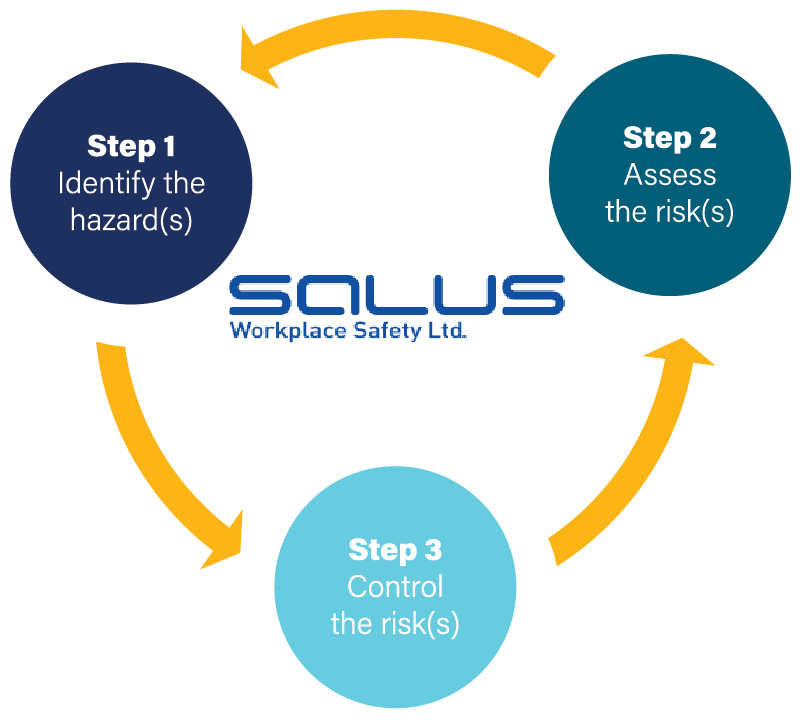
Legal:
Risk Assessment
PCBUs (businesses) are required by law to conduct health and safety risk assessments to ensure the safety of their employees and the public.
A health and safety risk assessment is a process that identifies, analyzes, controls, and eliminates hazards that can cause injury or illness to the workforce or others and negatively impact the business.
Simply put, a risk assessment is simply a careful examination of what, in your work, could cause harm to people, so that you can weigh up whether you have taken enough precautions or should do more to prevent harm. Workers and others have a right to be protected from harm caused by a failure to take reasonable control measures.
Staying safe requires knowledge, understanding, and skills. Follow the 5 Risk Assessment and Management Steps below:
Step 1. Identify the hazards
Walk around the workplace and assess activities, processes, or substances that could be a potential cause of injury.
Hazards can be classified into 4 different types, these are:
Physical (e.g., lifting, slips and trips, noise dust, machinery, etc.)
Mental (e.g., excess workload, long hours, bullying, etc.)
Chemical (e.g., asbestos, cleaning fluids, aerosols, etc.)
Biological (e.g., infectious diseases, tuberculosis, hepatitis, etc.)
Step 2. Determine who the hazard affects and how
Once hazards are identified, identify which persons in the organization are at risk. Review the work routine, location, and situation of your workers. Another group to consider are those people who don't work directly for your organisation but are exposed to potential hazards due to business operations. For example, in construction sites, you must consider other workers such as your contractor's workers and passersby who are also at risk of potential injury from noise, debris, chemical substances, etc.
Step 3. Assess the risks and take corrective action
Taking the right measures to control the risks so accidents are prevented
Businesses must now analyze risks to determine the corrective actions to take. Two key questions to ask when assessing the risks and formulating corrective actions are: 1. How bad would the most severe injury be if a person is exposed to the hazard? 2. How likely is the person to be injured if exposed to the hazard?
Step 4. Document the risk assessment
Risk assessments should be documented to prove that it was carried out, and as a basis for later review of working practices. You should include details of the hazards identified and the corrective action to be taken, who will be responsible for actioning, and a date for completion.
Using a health and safety risk assessment form will help to record the essentials and your reasoning.
The term controls can be confusing. Simply put a control is what you use to manage the risk. The highest level control is to ELIMINATE the hazard (e.g. wild tiger. Kill the tiger, or remove it from the environment). If elimination is not practicable, ISOLATE (cage the tiger to prevent it from getting to the people and vice versa). If isolating is not practicable then MINIMISE. Minimisation strategies reduce but do not eliminate the risk (e.g. using personal protective equipment and/or other measures like safe operating procedures, instructional warning signage "do not touch")
A word about forms . . . H & S Risk Assessments Checklists and Risk Assessment Worksheets. These can be very helpful but make sure you utilise one suitable for your work environment. Major airline companies, for example, have great health and safety management systems but if that is not your business you will find that you are walking into a minefield.
Environmental hazards are often missed.
Creating a checklist for new site assessments which includes both obvious physical hazards and the not-so-obvious environmental hazards is smart business. Consider factors such as odour, noise, vibrations, emissions, and structural ground that have the potential to negatively impact or affect people’s health and safety. Specific examples are asbestos, lead, pesticides, harmful gases, and trenching.
Step 5. Review risk assessment and update
Risk assessments should be reviewed regularly to check if the control measures taken are effective or need updating. It should be reviewed every time a business goes through changes that may increase the likelihood of new hazards arising. Once a year may be ok but here's some advice... ask yourself 2 questions.
1. What's the likelihood of this event happening? If the answer is frequent then a review may be justified every month! If the answer is only once a year then a review immediately before the risk is encountered is the right time to review because there may have been changes or simply to refamiliarize staff with the situation!
2. What's the consequence if the event happens? If the answer is major (leading to a serious injury or death) then a review would be justified irrespective of the frequency!
Health and Safety Risk Assessment forms are valuable tools used primarily to control risks in the workplace and to improve overall HSE management. These Health and Safety Risk Assessment templates can help you:
- identify health and safety hazards associated with job tasks,
- determine the people at risk,
- record and analyze significant data, and
- set preventive measures to further reduce or eliminate risks.
Examples include
-
Job Safety Analysis (JSA) and
-
TAKE 5s.